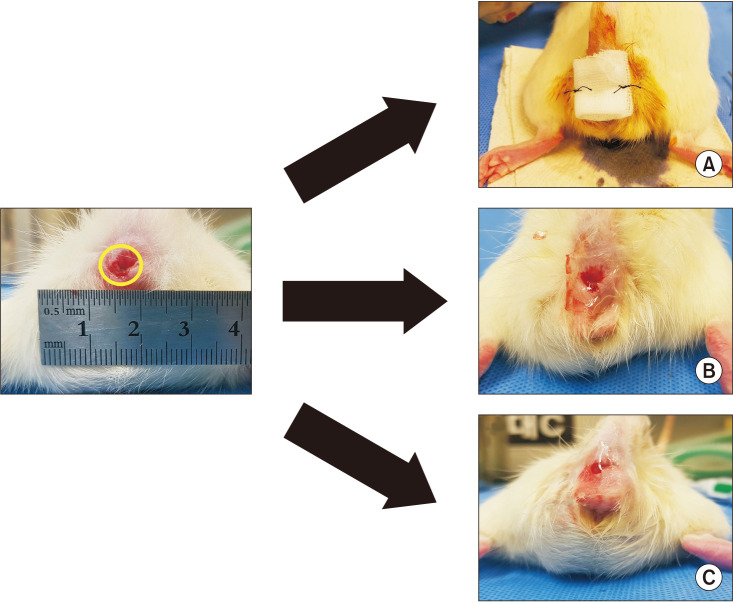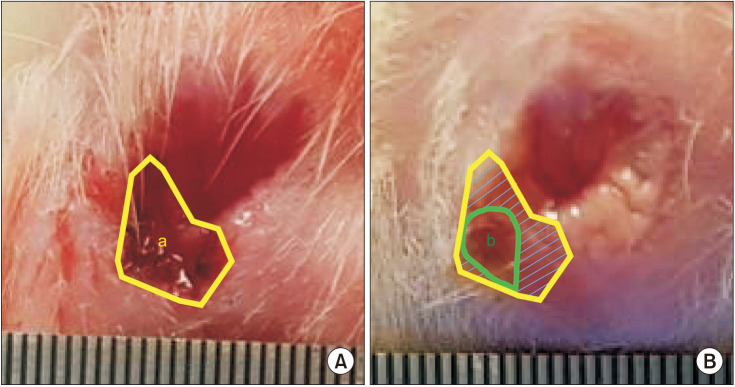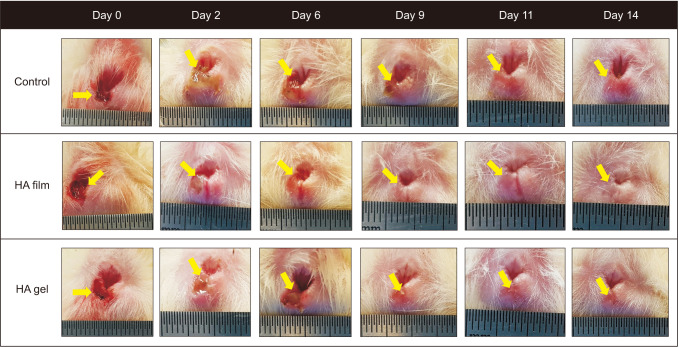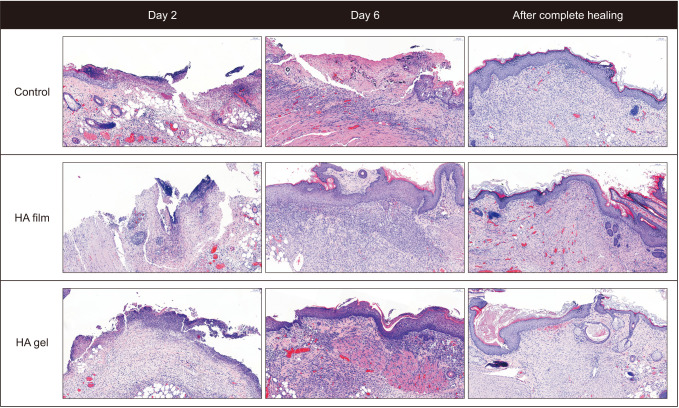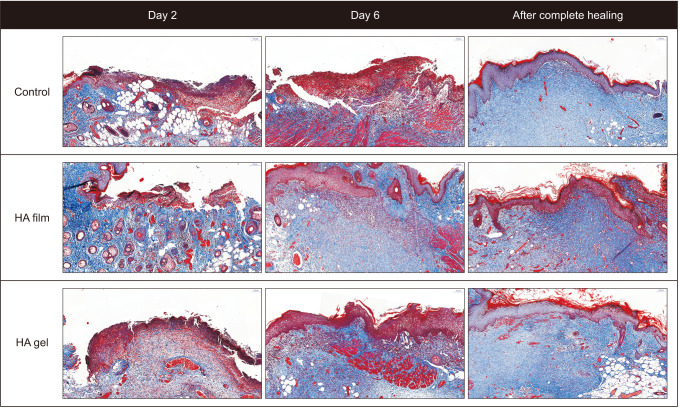Ann Surg Treat Res.
2021 Oct;101(4):206-213. 10.4174/astr.2021.101.4.206.
Efficacy of hyaluronic acid film on perianal wound healing in a rat model
- Affiliations
-
- 1Department of Surgery, Seoul National University Bundang Hospital, Seongnam, Korea
- 2Jinwoo Bio Co. Ltd., Seoul, Korea
- 3Department of Plastic Surgery, Seoul National University Bundang Hospital, Seongnam, Korea
- 4Department of Pathology, Seoul National University Bundang Hospital, Seongnam, Korea
- KMID: 2520651
- DOI: http://doi.org/10.4174/astr.2021.101.4.206
Abstract
- Purpose
Postoperative pain and delayed wound healing are the main complications following anal surgery associated with poor quality of life. Hyaluronic acid (HA) supports tissue regeneration and rapid wound healing by promoting cell proliferation and migration. We investigated the effects of HA on perianal wound healing in a rat model.
Methods
Forty-eight 8-week-old Sprague-Dawley rats with perianal wounds created by biopsy punch were divided into 3 groups: simple dressing with gauze (control), dressing with topical HA film, and dressing with topical HA gel. HA agents were not reapplied postoperatively. Wound healing was evaluated by measuring the healed area, and histological analyses were randomly performed using hematoxylin and eosin and Masson trichrome staining.
Results
Fewer mean days were required for complete wound healing in the HA film and HA gel groups than in the control group (11.6 vs. 11.9 vs. 13.8 days, respectively; P = 0.010). The healed area in the HA film group on day 11 was larger than that in the HA gel and control groups (80.2% vs. 61.9% vs. 53.2%, respectively; P < 0.001). Histologically, the HA film group showed accelerated reepithelialization, a rapid transition to lymphocyte-predominant inflammation, and increased fibroblastic proliferation and collagen deposition compared to the other groups. There was no treatment-related toxicity in the HA application groups.
Conclusion
Topical application of HA film to perianal wounds improves the wound healing rate in a rat model. This finding suggests a potential benefit of HA film application in promoting wound healing after anal surgery in humans.
Figure
Reference
-
1. de Oliveira JD, Carvalho LS, Gomes AM, Queiroz LR, Magalhães BS, Parachin NS. Genetic basis for hyper production of hyaluronic acid in natural and engineered microorganisms. Microb Cell Fact. 2016; 15:119. PMID: 27370777.
Article2. Kogan G, Soltés L, Stern R, Gemeiner P. Hyaluronic acid: a natural biopolymer with a broad range of biomedical and industrial applications. Biotechnol Lett. 2007; 29:17–25. PMID: 17091377.
Article3. Cai Z, Zhang H, Wei Y, Cong F. Hyaluronan-inorganic nanohybrid materials for biomedical applications. Biomacromolecules. 2017; 18:1677–1696. PMID: 28485601.
Article4. Voigt J, Driver VR. Hyaluronic acid derivatives and their healing effect on burns, epithelial surgical wounds, and chronic wounds: a systematic review and meta-analysis of randomized controlled trials. Wound Repair Regen. 2012; 20:317–331. PMID: 22564227.
Article5. Neuman MG, Nanau RM, Oruña-Sanchez L, Coto G. Hyaluronic acid and wound healing. J Pharm Pharm Sci. 2015; 18:53–60. PMID: 25877441.
Article6. Price RD, Myers S, Leigh IM, Navsaria HA. The role of hyaluronic acid in wound healing: assessment of clinical evidence. Am J Clin Dermatol. 2005; 6:393–402. PMID: 16343027.7. Mansouri Y, Goldenberg G. Update on hyaluronic acid fillers for facial rejuvenation. Cutis. 2015; 96:85–88. PMID: 26367746.8. Johanson JF, Sonnenberg A. The prevalence of hemorrhoids and chronic constipation: an epidemiologic study. Gastroenterology. 1990; 98:380–386. PMID: 2295392.9. National Health Insurance Service. National Health Insurance Statistical Yearbook in Korea, 2018. Wonju (KR): National Health Insurance Service;2018.10. Jacobs D. Clinical practice. Hemorrhoids. N Engl J Med. 2014; 371:944–951. PMID: 25184866.11. Nicholson TJ, Armstrong D. Topical metronidazole (10 percent) decreases posthemor rhoidectomy pain and improves healing. Dis Colon Rectum. 2004; 47:711–716. PMID: 15054681.12. Gupta PJ, Heda PS, Kalaskar S, Tamaskar VP. Topical sucralfate decreases pain after hemorrhoidectomy and improves healing: a randomized, blinded, controlled study. Dis Colon Rectum. 2008; 51:231–234. PMID: 18095028.
Article13. Karanlik H, Akturk R, Camlica H, Asoglu O. The effect of glyceryl trinitrate ointment on posthemorrhoidectomy pain and wound healing: results of a randomized, double-blind, placebo-controlled study. Dis Colon Rectum. 2009; 52:280–285. PMID: 19279424.14. Eshghi F, Hosseinimehr SJ, Rahmani N, Khademloo M, Norozi MS, Hojati O. Effects of A loe vera cream on posthemor rhoidectomy pain and wound healing: results of a randomized, blind, placebo-control study. J Altern Complement Med. 2010; 16:647–650. PMID: 20569031.15. Xu X, Li X, Zhang L, Liu Z, Pan Y, Chen D, et al. Enhancement of wound healing by the traditional Chinese medicine herbal mixture sophora flavescens in a rat model of perianal ulceration. In Vivo. 2017; 31:543–549. PMID: 28652418.16. Ala S, Alvandipour M, Saeedi M, Hamidian M, Shiva A, Rahmani N, Faramarzi F. Effects of topical atorvastatin (2 %) on posthemorrhoidectomy pain and wound healing: a randomized double-blind placebo-controlled clinical trial. World J Surg. 2017; 41:596–602. PMID: 27738832.17. Duman N, Duman R, Tosun M, Akıcı M, Göksel E, Gökçe B, et al. Topical folinic acid enhances wound healing in rat model. Adv Med Sci. 2018; 63:347–352. PMID: 30092503.
Article18. Chen S, Huan Z, Zhang L, Chang J. The clinical application of a silicate-based wound dressing (DermFactor®) for wound healing after anal surgery: a randomized study. Int J Surg. 2018; 52:229–232. PMID: 29481992.
Article19. DK KweonSH Park. Jinwoo Bio Co. Ltd.Method for manufacturing hyaluronate fibers by using melt spinning and hyaluronate fibers manufactured thereby. United States patent. US 20180243471A1. 2018. 8. 30.20. Zhou X, Patel D, Sen S, Shanmugam V, Sidawy A, Mishra L, et al. Poly-ADP-ribose polymerase inhibition enhances ischemic and diabetic wound healing by promoting angiogenesis. J Vasc Surg. 2017; 65:1161–1169. PMID: 27288104.
Article21. Gallagher KA, Joshi A, Carson WF, Schaller M, Allen R, Mukerjee S, et al. Epigenetic changes in bone marrow progenitor cells influence the inflammatory phenotype and alter wound healing in type 2 diabetes. Diabetes. 2015; 64:1420–1430. PMID: 25368099.
Article22. Aya KL, Stern R. Hyaluronan in wound healing: rediscovering a major player. Wound Repair Regen. 2014; 22:579–593. PMID: 25039417.
Article23. Hoffmann A, Hoing JL, Newman M, Simman R. Role of hyaluronic acid treatment in the prevention of keloid scarring. J Am Coll Clin Wound Spec. 2013; 4:23–31. PMID: 24936445.24. Watson AJ, Cook J, Hudson J, Kilonzo M, Wood J, Bruhn H, et al. A pragmatic multicentre randomised controlled trial comparing stapled haemorrhoidopexy with traditional excisional surgery for haemorrhoidal disease: the eTHoS study. Health Technol Assess. 2017; 21:1–224.
Article25. Liu JW, Lin CC, Kiu KT, Wang CY, Tam KW. Effect of glyceryl trinitrate ointment on pain control after hemorrhoidectomy: a meta-analysis of randomized controlled trials. World J Surg. 2016; 40:215–224. PMID: 26578318.
Article26. MottT , Latimer K, Edwards C. Hemorrhoids: diagnosis and treatment options. Am Fam Physician. 2018; 97:172–179. PMID: 29431977.
- Full Text Links
- Actions
-
Cited
- CITED
-
- Close
- Share
- Similar articles
-
- Accelerated wound healing after topical application of hyaluronic acid cotton to hemorrhoidectomy wounds in a rat model
- The Effect of Hyaluronic Acid and Epidermal Growth Factor on Cultured Corneal Epithelial Cells in the Rabbit
- The Effect of Hyaluronic Acid on Fibroblast Proliferation in Vitro and Skin Wound Healing in Vivo
- The effects of hyaluronic acid gel on the healing of oral mucosa
- The Comparison of the Corneal Epithelial Healing According to Treatment Modalities in Rabbit

